介紹
為什么要使用集群流控呢?
相對于單機流控而言,我們給每臺機器設(shè)置單機限流閾值,在理想情況下整個集群的限流閾值為機器數(shù)量??單機閾值。不過實際情況下流量到每臺機器可能會不均勻,會導(dǎo)致總量沒有到的情況下某些機器就開始限流。因此僅靠單機維度去限制的話會無法精確地限制總體流量。而集群流控可以精確地控制整個集群的調(diào)用總量,結(jié)合單機限流兜底,可以更好地發(fā)揮流量控制的效果。
基于單機流量不均的問題以及如何設(shè)置集群整體的QPS的問題,我們需要創(chuàng)建一種集群限流的模式,這時候我們很自然地就想到,可以找一個 server 來專門統(tǒng)計總的調(diào)用量,其它的實例都與這臺 server 通信來判斷是否可以調(diào)用。這就是最基礎(chǔ)的集群流控的方式。
原理
集群限流的原理很簡單,和單機限流一樣,都需要對 qps 等數(shù)據(jù)進(jìn)行統(tǒng)計,區(qū)別就在于單機版是在每個實例中進(jìn)行統(tǒng)計,而集群版是有一個專門的實例進(jìn)行統(tǒng)計。
這個專門的用來統(tǒng)計數(shù)據(jù)的稱為 Sentinel 的 token server,其他的實例作為 Sentinel 的 token client 會向 token server 去請求 token,如果能獲取到 token,則說明當(dāng)前的 qps 還未達(dá)到總的閾值,否則就說明已經(jīng)達(dá)到集群的總閾值,當(dāng)前實例需要被 block,如下圖所示:
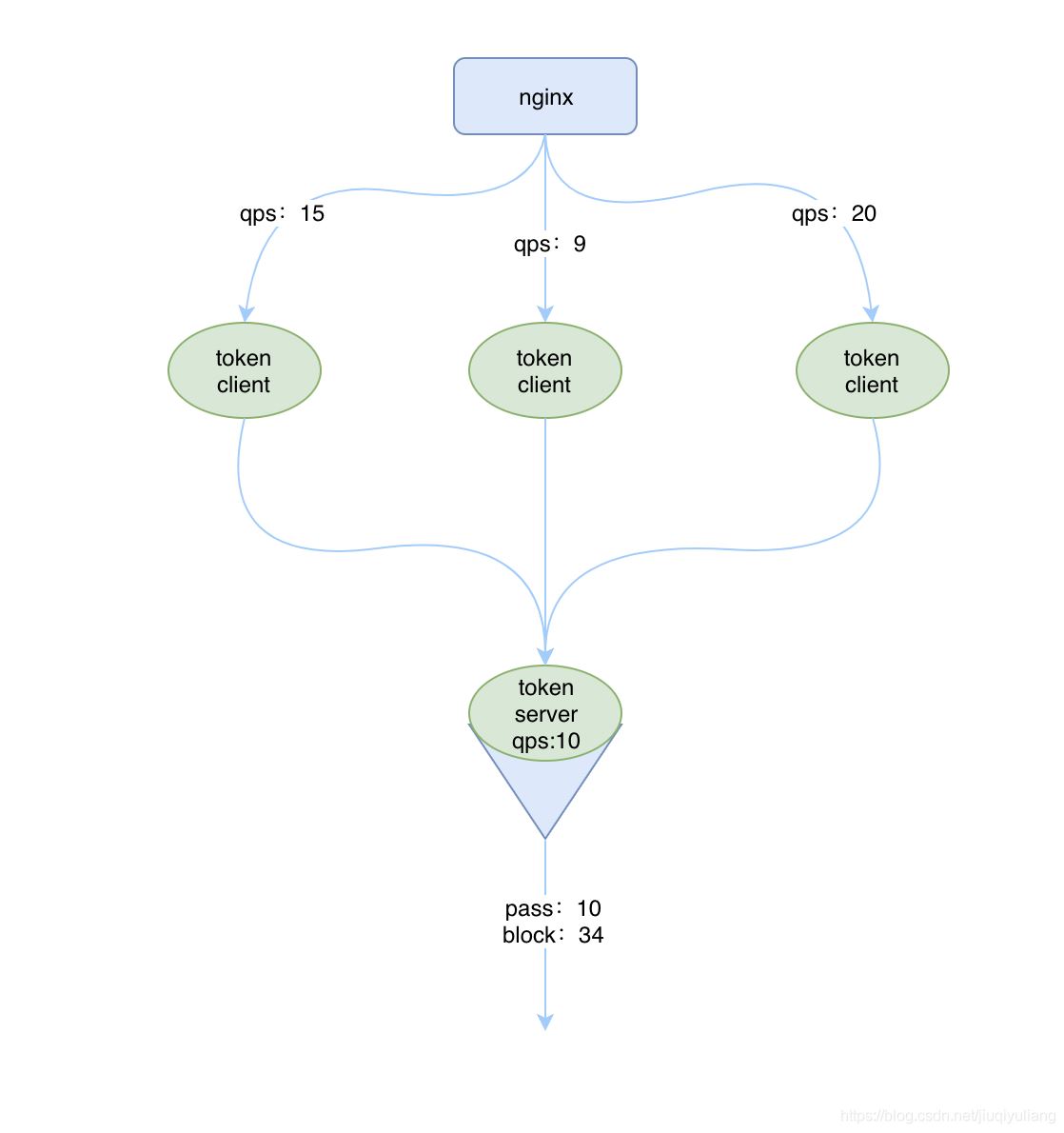
和單機流控相比,集群流控中共有兩種身份:
- Token Client:集群流控客戶端,用于向所屬 Token Server 通信請求 token。集群限流服務(wù)端會返回給客戶端結(jié)果,決定是否限流。
- Token Server:即集群流控服務(wù)端,處理來自 Token Client 的請求,根據(jù)配置的集群規(guī)則判斷是否應(yīng)該發(fā)放 token(是否允許通過)。
而單機流控中只有一種身份,每個 sentinel 都是一個 token server。
注意,集群限流中的 token server 是單點的,一旦 token server 掛掉,那么集群限流就會退化成單機限流的模式。
Sentinel 集群流控支持限流規(guī)則和熱點規(guī)則兩種規(guī)則,并支持兩種形式的閾值計算方式:
- 集群總體模式:即限制整個集群內(nèi)的某個資源的總體 qps 不超過此閾值。
- 單機均攤模式:單機均攤模式下配置的閾值等同于單機能夠承受的限額,token server 會根據(jù)連接數(shù)來計算總的閾值(比如獨立模式下有 3 個 client 連接到了 token server,然后配的單機均攤閾值為 10,則計算出的集群總量就為 30),按照計算出的總的閾值來進(jìn)行限制。這種方式根據(jù)當(dāng)前的連接數(shù)實時計算總的閾值,對于機器經(jīng)常進(jìn)行變更的環(huán)境非常適合。
部署方式
token server 有兩種部署方式:
一種是獨立部署,就是單獨啟動一個 token server 服務(wù)來處理 token client 的請求,如下圖所示:
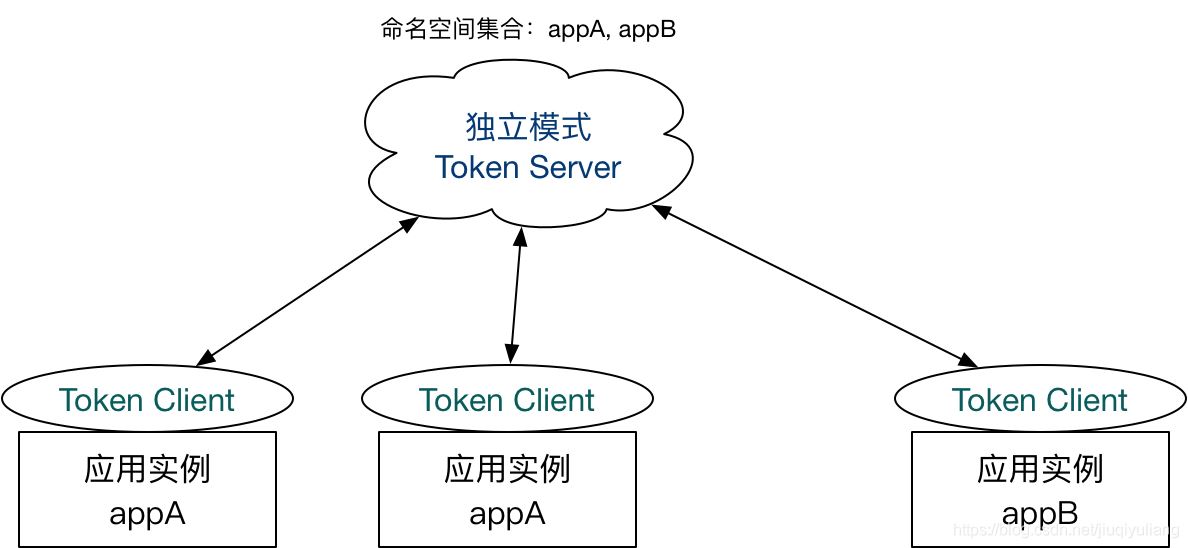
如果獨立部署的 token server 服務(wù)掛掉的話,那其他的 token client 就會退化成本地流控的模式,也就是單機版的流控,所以這種方式的集群限流需要保證 token server 的高可用性。
一種是嵌入部署,即作為內(nèi)置的 token server 與服務(wù)在同一進(jìn)程中啟動。在此模式下,集群中各個實例都是對等的,token server 和 client 可以隨時進(jìn)行轉(zhuǎn)變,如下圖所示:
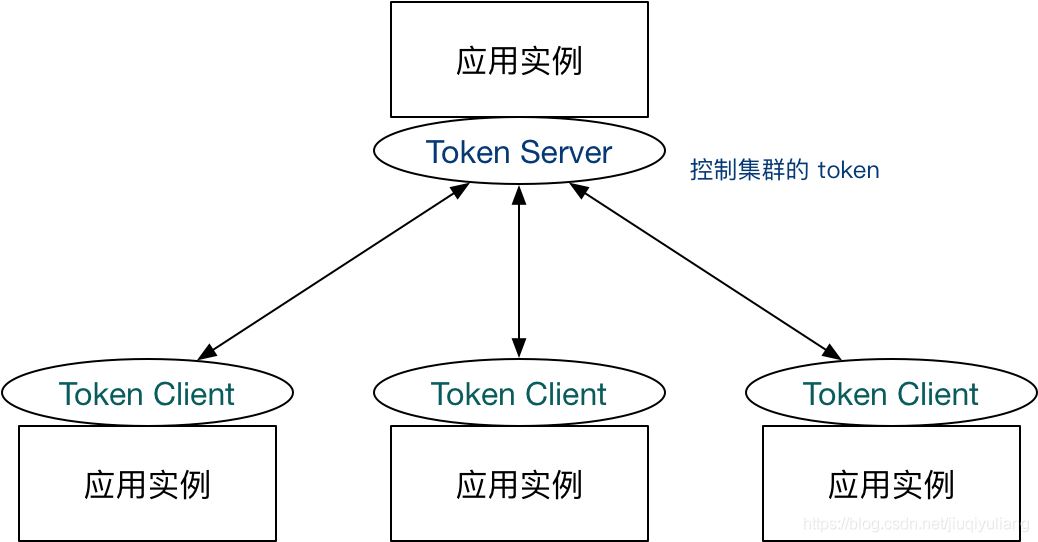
嵌入式部署的模式中,如果 token server 服務(wù)掛掉的話,我們可以將另外一個 token client 升級為token server來,當(dāng)然啦如果我們不想使用當(dāng)前的 token server 的話,也可以選擇另外一個 token client 來承擔(dān)這個責(zé)任,并且將當(dāng)前 token server 切換為 token client。Sentinel 為我們提供了一個 api 來進(jìn)行 token server 與 token client 的切換:
- http://<ip>:<port>/setClusterMode?mode=<xxx>
其中 mode 為 0 代表 client,1 代表 server,-1 代表關(guān)閉。
PS:注意應(yīng)用端需要引入集群限流客戶端或服務(wù)端的相應(yīng)依賴。
集群限流控制臺
sentinel為用戶提供集群限流控制臺功能,能夠通過控制臺配置集群的限流規(guī)則以及配置集群的Server與Client。
集群限流客戶端
要想使用集群限流功能,必須引入集群限流 client 相關(guān)依賴:
- <dependency>
- <groupId>com.alibaba.csp</groupId>
- <artifactId>sentinel-cluster-client-default</artifactId>
- <version>1.8.0</version>
- </dependency>
集群限流服務(wù)端
要想使用集群限流服務(wù)端,必須引入集群限流 server 相關(guān)依賴:
- <dependency>
- <groupId>com.alibaba.csp</groupId>
- <artifactId>sentinel-cluster-server-default</artifactId>
- <version>1.8.0</version>
- </dependency>
我們結(jié)合server和client實現(xiàn)一個嵌入式模式。在pom中同時引入上面的兩個依賴,并配置sentinel控制臺地址,實現(xiàn)一個查詢訂單的接口。
pom
- <dependency>
- <groupId>com.alibaba.csp</groupId>
- <artifactId>sentinel-cluster-server-default</artifactId>
- </dependency>
- <dependency>
- <groupId>com.alibaba.csp</groupId>
- <artifactId>sentinel-cluster-client-default</artifactId>
- </dependency>
application.yml
- server:
- port: 9091
- spring:
- application:
- name: cloudalibaba-sentinel-clusterServer
- cloud:
- sentinel:
- transport:
- #配置sentinel dashboard地址
- dashboard: localhost:8080
- port: 8719 #默認(rèn)8719端口
OrderController
- @RestController
- public class OrderController {
- /**
- * 查詢訂單
- * @return
- */
- @GetMapping("/order/{id}")
- public CommonResult<Order> getOrder(@PathVariable("id") Long id){
- Order order = new Order(id, "212121");
- return CommonResult.success(order.toString());
- }
- }
代碼示例如cloudalibaba-sentinel-cluster-embedded9091
修改VM options配置,啟動三個不同端口的實例,即可。
- -Dserver.port=9091 -Dproject.name=cloudalibaba-sentinel-clusterServer -Dcsp.sentinel.log.use.pid=true
- -Dserver.port=9092 -Dproject.name=cloudalibaba-sentinel-clusterServer -Dcsp.sentinel.log.use.pid=true
- -Dserver.port=9093 -Dproject.name=cloudalibaba-sentinel-clusterServer -Dcsp.sentinel.log.use.pid=true
控制臺配置
登錄sentinel的控制臺,并有訪問量后,我們就可以在 Sentinel上面看到集群流控,如下圖所示:
點擊添加Token Server。
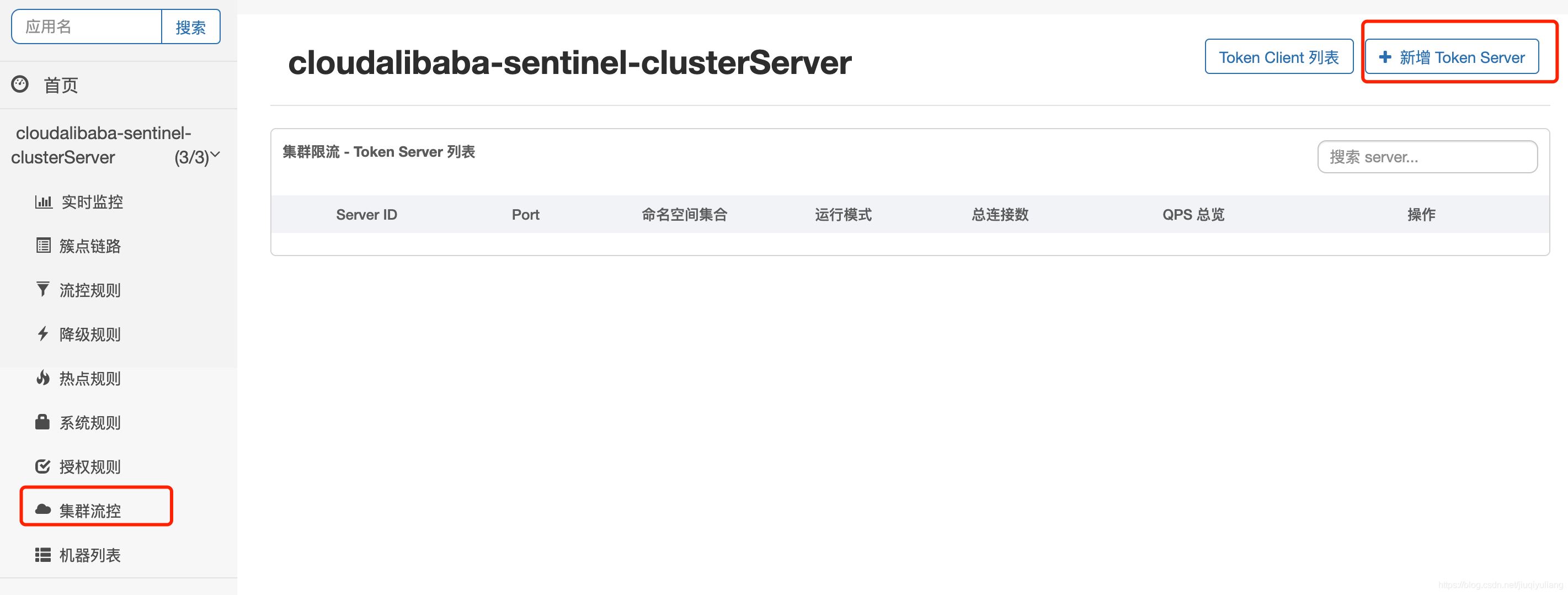
從實例列表中選擇一個作為Server端,其他作為Client端,并選中到右側(cè)Client列表,配置token sever端的最大允許的QPS,用于對 Token Server 的資源使用進(jìn)行限制,防止在嵌入模式下影響應(yīng)用本身。
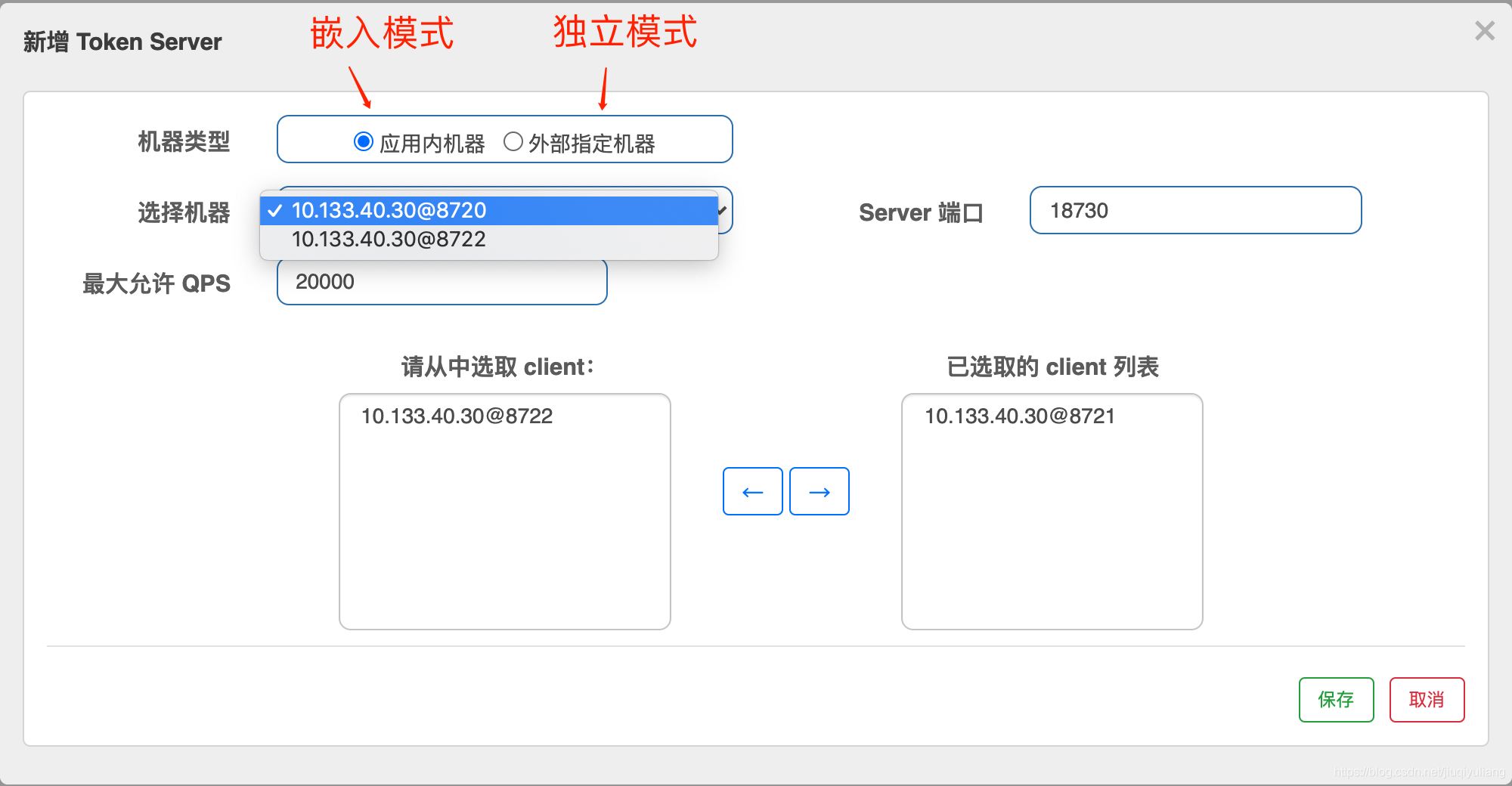
配置完成之后的Token Server列表,如下圖所示

使用控制臺配置token Server、token Client以及限流規(guī)則,有很多的缺點:
1、限流規(guī)則,不能持久化,應(yīng)用重啟之后,規(guī)則丟失。
2、token Server 、token Client配置也會丟失。
官方推薦給集群限流服務(wù)端注冊動態(tài)配置源來動態(tài)地進(jìn)行配置。我們使用nacos作為配置中心,動態(tài)配置客戶端與服務(wù)端屬性以及限流規(guī)則,實現(xiàn)動態(tài)集群限流。
sentinel結(jié)合nacos實現(xiàn)集群限流
我們使用Nacos對cloudalibaba-sentinel-cluster-embedded9091進(jìn)行改造,實現(xiàn)動態(tài)配置源來動態(tài)進(jìn)行配置。
配置源注冊的相關(guān)邏輯可以置于 InitFunc 實現(xiàn)類中,并通過 SPI 注冊,在 Sentinel 初始化時即可自動進(jìn)行配置源加載監(jiān)聽。
嵌入模式部署
添加ClusterInitFunc類
- public class ClusterInitFunc implements InitFunc {
- //應(yīng)用名稱
- private static final String APP_NAME = AppNameUtil.getAppName();
- //nacos集群地址
- private final String remoteAddress = "localhost:8848";
- //nacos配置的分組名稱
- private final String groupId = "SENTINEL_GROUP";
- //配置的dataId
- private final String flowDataId = APP_NAME + Constants.FLOW_POSTFIX;
- private final String paramDataId = APP_NAME + Constants.PARAM_FLOW_POSTFIX;
- private final String configDataId = APP_NAME + Constants.CLIENT_CONFIG_POSTFIX;
- private final String clusterMapDataId = APP_NAME + Constants.CLUSTER_MAP_POSTFIX;
- private static final String SEPARATOR = "@";
- @Override
- public void init() {
- // Register client dynamic rule data source.
- //動態(tài)數(shù)據(jù)源的方式配置sentinel的流量控制和熱點參數(shù)限流的規(guī)則。
- initDynamicRuleProperty();
- // Register token client related data source.
- // Token client common config
- // 集群限流客戶端的配置屬性
- initClientConfigProperty();
- // Token client assign config (e.g. target token server) retrieved from assign map:
- //初始化Token客戶端
- initClientServerAssignProperty();
- // Register token server related data source.
- // Register dynamic rule data source supplier for token server:
- //集群的流控規(guī)則,比如限制整個集群的流控閥值,啟動的時候需要添加-Dproject.name=項目名
- registerClusterRuleSupplier();
- // Token server transport config extracted from assign map:
- //初始化server的端口配置
- initServerTransportConfigProperty();
- // Init cluster state property for extracting mode from cluster map data source.
- //初始化集群中服務(wù)是客戶端還是服務(wù)端
- initStateProperty();
- }
- private void initDynamicRuleProperty() {
- //流量控制的DataId分別是APP_NAME + Constants.FLOW_POSTFIX;熱點參數(shù)限流規(guī)則的DataId是APP_NAME + Constants.PARAM_FLOW_POSTFIX;
- ReadableDataSource<String, List<FlowRule>> ruleSource = new NacosDataSource<>(remoteAddress, groupId,
- flowDataId, source -> jsON.parseObject(source, new TypeReference<List<FlowRule>>() {}));
- FlowRuleManager.register2Property(ruleSource.getProperty());
- ReadableDataSource<String, List<ParamFlowRule>> paramRuleSource = new NacosDataSource<>(remoteAddress, groupId,
- paramDataId, source -> JSON.parseObject(source, new TypeReference<List<ParamFlowRule>>() {}));
- ParamFlowRuleManager.register2Property(paramRuleSource.getProperty());
- }
- private void initClientConfigProperty() {
- ReadableDataSource<String, ClusterClientConfig> clientConfigDs = new NacosDataSource<>(remoteAddress, groupId,
- configDataId, source 編程客棧-> JSON.parseObject(source, new TypeReference<ClusterClientConfig>() {}));
- ClusterClientConfigManager.registerClientConfigProperty(clientConfigDs.getProperty());
- }
- private void initServerTransportConfigProperty() {
- ReadableDataSource<String, ServerTransportConfig> serverTransportDs = new NacosDataSource<>(remoteAddress, groupId,
- clusterMapDataId, source -> {
- List<ClusterGroupEntity> groupList = new Gson().fromJson(source, new TypeToken<List<ClusterGroupEntity>>(){}.getType());
- return Optional.ofNullable(groupList)
- www.cppcns.com .flatMap(this::extractServerTransportConfig)
- .orElse(null);
- });
- ClusterServerConfigManager.registerServerTransportProperty(serverTransportDs.getProperty());
- }
- private void registerClusterRuleSupplier() {
- // Register cluster flow rule property supplier which creates data source by namespace.
- // Flow rule dataId format: ${namespace}-flow-rules
- ClusterFlowRuleManager.setPropertySupplier(namespace -> {
- ReadableDataSource<String, List<FlowRule>> ds = new NacosDataSource<>(remoteAddress, groupId,
- namespace + Constants.FLOW_POSTFIX, source -> JSON.parseObject(source, new TypeReference<List<FlowRule>>() {}));
- return ds.getProperty();
- });
- // Register cluster parameter flow rule property supplier which creates data source by namespace.
- ClusterParamFlowRuleManager.setPropertySupplier(namespace -> {
- ReadableDataSource<String, List<ParamFlowRule>> ds = new NacosDataSource<>(remoteAddress, groupId,
- namespace + Constants.PARAM_FLOW_POSTFIX, source -> JSON.parseObject(source, new TypeReference<List<ParamFlowRule>>() {}));
- return ds.getProperty();
- });
- }
- private void initClientServerAssignProperty() {
- // Cluster map format:
- // [{"clientSet":["112.12.88.66@8729","112.12.88.67@8727"],"ip":"112.12.88.68","serverId":"112.12.88.68@8728","port":11111}]
- // serverId: <ip@commandPort>, commandPort for port exposed to Sentinel dashboard (transport module)
- ReadableDataSource<String, ClusterClientAssignConfig> clientAssignDs = new NacosDataSource<>(remoteAddress, groupId,
- clusterMapDataId, source -> {
- List<ClusterGroupEntity> groupList = new Gson().fromJson(source, new TypeToken<List<ClusterGroupEntity>>(){}.getType());
- return Optional.ofNullable(groupList)
- .flatMap(this::extractClientAssignment)
- .orElse(null);
- });
- ClusterClientConfigManager.registerServerAssignProperty(clientAssignDs.getProperty());
- }
- private void initStateProperty() {
- // Cluster map format:
- // [{"clientSet":["112.12.88.66@8729","112.12.88.67@8727"],"ip":"112.12.88.68","serverId":"112.12.88.68@8728","port":11111}]
- // serverId: <ip@commandPort>, commandPort for port exposed to Sentinel dashboard (transport module)
- ReadableDataSource<String, Integer> clusterModeDs = new NacosDataSource<>(remoteAddress, groupId,
- clusterMapDataId, source -> {
- List<ClusterGroupEntity> groupList = new Gson().fromJson(source, new TypeToken<List<ClusterGroupEntity>>(){}.getType());
- return Optional.ofNullable(groupList)
- .map(this::extractMode)
- .orElse(ClusterStateManager.CLUSTER_NOT_STARTED);
- });
- ClusterStateManager.registerProperty(clusterModeDs.getProperty());
- }
- private int extractMode(List<ClusterGroupEntity> groupList) {
- // If any server group serverId matches current, then it's token server.
- if (groupList.stream().anyMatch(this::machineEqual)) {
- return ClusterStateManager.CLUSTER_SERVER;
- }
- // If current machine belongs to any of the token server group, then it's token client.
- // Otherwise it's unassigned, should be set to NOT_STARTED.
- boolean canBeClient = groupList.stream()
- .flatMap(e -> e.getClientSet().stream())
- .filter(Objects::nonNull)
- .anyMatch(e -> e.equals(getCurrentMachineId()));
- return canBeClient ? ClusterStateManager.CLUSTER_CLIENT : ClusterStateManager.CLUSTER_NOT_STARTED;
- }
- private Optional<ServerTransportConfig> extractServerTransportConfig(List<ClusterGroupEntity> groupList) {
- return groupList.stream()
- .filter(this::machineEqual)
- .findAny()
- .map(e -> new ServerTransportConfig().setPort(e.getPort()).setIdleSeconds(600));
- }
- private Optional<ClusterClientAssignConfig> extractClientAssignment(List<ClusterGroupEntity> groupList) {
- if (groupList.stream().anyMatch(this::mwww.cppcns.comachineEqual)) {
- return Optional.empty();
- }
- // Build client assign config from tJTVlRhe client set of target server group.
- for (ClusterGroupEntity group : groupList) {
- if (group.getClientSet().contains(getCurrentMachineId())) {
- String ip = group.getIp();
- Integer port = group.getPort();
- return Optional.of(new ClusterClientAssignConfig(ip, port));
- }
- }
- return Optional.empty();
- }
- private boolean machineEqual(/*@Valid*/ ClusterGroupEntity group) {
- return getCurrentMachineId().equals(group.getServerId());
- }
- private String getCurrentMachineId() {
- // Note: this may not work well for container-based env.
- return HostNameUtil.getIp() + SEPARATOR + TransportConfig.getRuntimePort();
- }
- }
在resources文件夾下創(chuàng)建META-INF/service,,然后創(chuàng)建一個叫做com.alibaba.csp.sentinel.init.InitFunc的文件,在文件中指名實現(xiàn)InitFunc接口的類全路徑,內(nèi)容如下:
- com.liang.springcloud.alibaba.init.ClusterInitFunc
添加配置的解析類:
- public class ClusterGroupEntity implements Serializable {
- private String serverId;
- private String ip;
- private Integer port;
- private Set<String> clientSet;
- public String getServerId() {
- return serverId;
- }
- public void setServerId(String serverId) {
- this.serverId = serverId;
- }
- public String getIp() {
- return ip;
- }
- public void setIp(String ip) {
- this.ip = ip;
- }
- public Integer getPort() {
- return port;
- }
- public void setPort(Integer port) {
- this.port = port;
- }
- public Set<String> getClientSet() {
- return clientSet;
- }
- public void setClientSet(Set<String> clientSet) {
- this.clientSet = clientSet;
- }
- @Override
- public String toString() {
- return "ClusterGroupEntity{" +
- "serverId='" + serverId + '\'' +
- ", ip='" + ip + '\'' +
- ", port=" + port +
- ", clientSet=" + clientSet +
- '}';
- }
- }
在Nacos中添加動態(tài)規(guī)則配置,以及token server與token client的配置:
DataId:cloudalibaba-sentinel-clusterServer-flow-rules Group:SENTINEL_GROUP 配置內(nèi)容(json格式):
- [
- {
- "resource" : "/order/{id}", // 限流的資源名稱
- "grade" : 1, // 限流模式為:qps,線程數(shù)限流0,qps限流1
- "count" : 20, // 閾值為:20
- "clusterMode" : true, // 是否是集群模式,集群模式為:true
- "clusterConfig" : {
- "flowId" : 111, // 全局唯一id
- "thresholdType" : 1, // 閾值模式為:全局閾值,0是單機均攤,1是全局閥值
- "fallbackToLocalWhenFail" : true // 在 client 連接失敗或通信失敗時,是否退化到本地的限流模式
- }
- }
- ]
DataId:cloudalibaba-sentinel-clusterServer-cluster-client-config Group:SENTINEL_GROUP 配置內(nèi)容(json格式):
- {
- "requestTimeout": 20
- }
DataId:cloudalibaba-sentinel-clusterServer-cluster-map Group:SENTINEL_GROUP 配置內(nèi)容(json格式):
- [{
- "clientSet": ["10.133.40.30@8721", "10.133.40.30@8722"],
- "ip": "10.133.40.30",
- "serverId": "10.133.40.30@8720",
- "port": 18730 //這個端口是token server通信的端口
- }]
重新啟動服務(wù),并訪問接口,我們可以看到流控規(guī)則與集群流控都自動配置完成。我們需要測試,我們集群流控是否已經(jīng)生效。
不斷執(zhí)行以下命令:
- ab -n 100 -c 50 http://localhost:9091/order/1
- ab -n 100 -c 50 http://localhost:9092/order/3
- ab -n 100 -c 50 http://localhost:9093/order/1
測試效果圖:
我們從實時監(jiān)控圖上可以看出,資源名為/order/{id},整個集群的QPS為20,跟我們的配置是一樣的。當(dāng)作為token server的機器掛掉后,集群限流會退化到 local 模式的限流,即在本地按照單機閾值執(zhí)行限流檢查。

Token Server 分配配置:
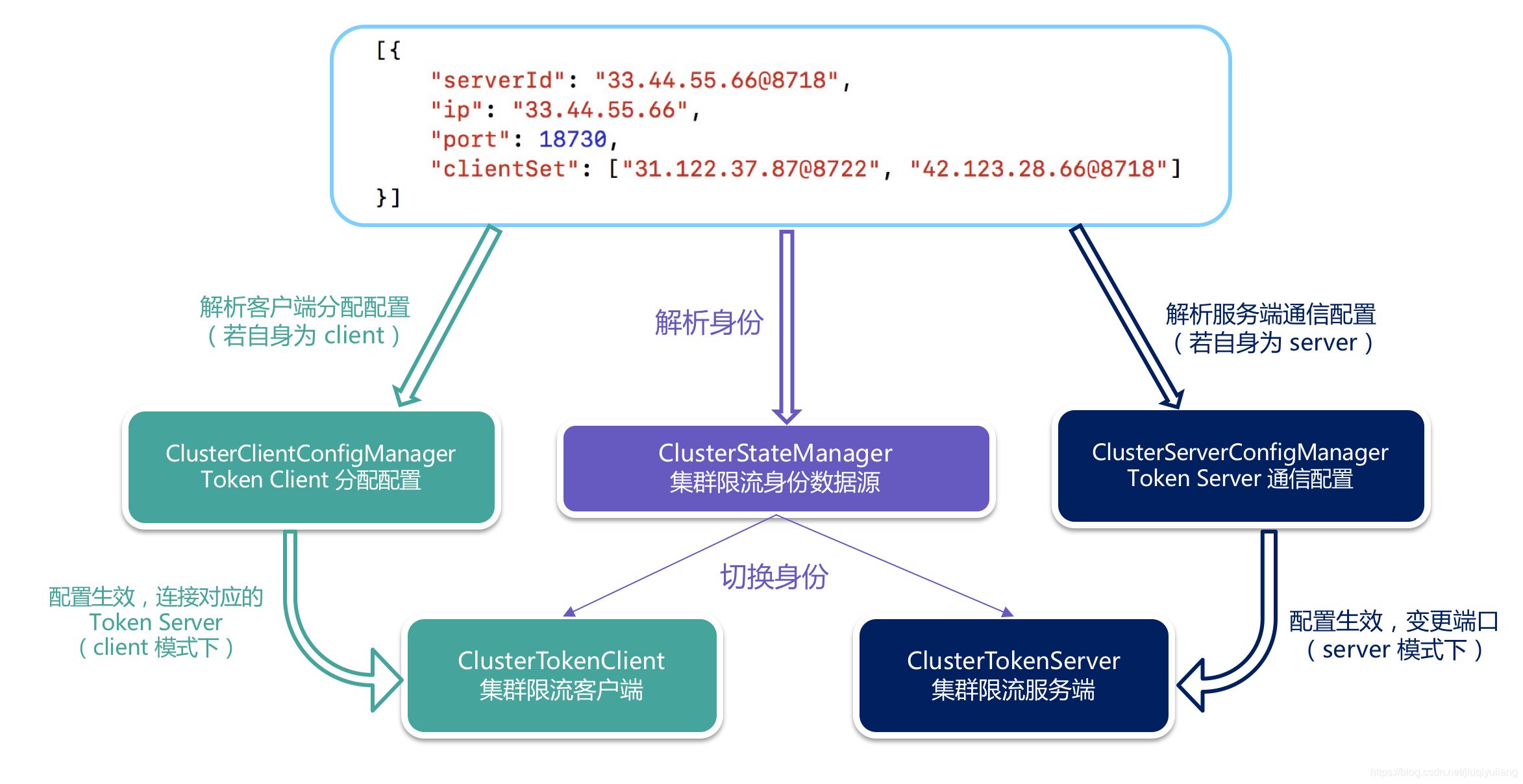
上面這張圖可以很好幫忙我們解釋嵌入模式的具體實現(xiàn)。通過配置信息解析,管理我們的token server與token client。
適用范圍:
嵌入模式適合某個應(yīng)用集群內(nèi)部的流控。由于隔離性不佳,token server會影響應(yīng)用本身,需要限制 token server 的總QPS。
獨立模式部署
獨立模式相對于嵌入模式而言就是將token server與應(yīng)用隔離,進(jìn)行獨立部署。將嵌入模式中token server和token client分離,分別進(jìn)行配置。我們只需要將 InitFunc 實現(xiàn)類進(jìn)行拆分。
token server的nacos配置
server的名稱空間配置,(集群的namespace或客戶端項目名)如下:
DataId:cluster-server-namespace-set Group:SENTINEL_ALONE_GROUP 配置內(nèi)容(json格式):
- [
- "cloudalibaba-sentinel-cluster-client-alone"
- ]
server的通信端口配置,如下:
DataId:cluster-server-transport-config Group:SENTINEL_ALONE_GROUP 配置內(nèi)容(json格式):
- {
- "idleSecods":600,
- "port": 18730
- }
Token sever的流控限制配置,如下:
DataId:cluster-server-flow-config Group:SENTINEL_ALONE_GROUP 配置內(nèi)容(json格式):
- {
- "exceedCount":1.0,
- "maxAllowedQps":20000,
- "namespace":"cloudalibaba-sentinel-clust編程客棧er-client-alone"
- }
token server的host地址與端口號配置,如下:
DataId: cluster-server-config Group:SENTINEL_ALONE_GROUP 配置內(nèi)容(json格式):
- {
- "serverHost": "10.133.40.30",
- "serverPort": 18730
- }
token server的InitFunc類:
- /**
- * @PROJECT_NAME: SpringCloud-Learning
- * @USER: yuliang
- * @DESCRIPTION:
- * @DATE: 2021-04-01 10:01
- */
- public class ClusterServerInitFunc implements InitFunc {
- //nacos集群地址
- private final String remoteAddress = "localhost:8848";
- //配置的分組名稱
- private final String groupId = "SENTINEL_ALONE_GROUP";
- //配置的dataId
- private final String namespaceSetDataId = "cluster-server-namespace-set";
- private final String serverTransportDataId = "cluster-server-transport-config";
- private final String serverFlowDataId = "cluster-server-flow-config";
- @Override
- public void init() {
- //監(jiān)聽特定namespace(集群的namespace或客戶端項目名)下的集群限流規(guī)則
- initPropertySupplier();
- // 設(shè)置tokenServer管轄的作用域(即管理哪些應(yīng)用)
- initTokenServerNameSpaces();
- // Server transport configuration data source.
- //Server端配置
- initServerTransportConfig();
- // 初始化最大qps
- initServerFlowConfig();
- //初始化服務(wù)器狀態(tài)
- initStateProperty();
- }
- private void initPropertySupplier(){
- // Register cluster flow rule property supplier which creates data source by namespace.
- // Flow rule dataId format: ${namespace}-flow-rules
- ClusterFlowRuleManager.setPropertySupplier(namespace -> {
- ReadableDataSource<String, List<FlowRule>> ds = new NacosDataSource<>(remoteAddress, groupId,
- namespace + Constants.FLOW_POSTFIX,
- source -> JSON.parseObject(source, new TypeReference<List<FlowRule>>() {}));
- return ds.getProperty();
- });
- // Register cluster parameter flow rule property supplier which creates data source by namespace.
- ClusterParamFlowRuleManager.setPropertySupplier(namespace -> {
- ReadableDataSource<String, List<ParamFlowRule>> ds = new NacosDataSource<>(remoteAddress, groupId,
- namespace + Constants.PARAM_FLOW_POSTFIX, source -> JSON.parseObject(source, new TypeReference<List<ParamFlowRule>>() {}));
- return ds.getProperty();
- });
- }
- private void initTokenServerNameSpaces(){
- // Server namespace set (scope) data source.
- ReadableDataSource<String, Set<String>> namespaceDs = new NacosDataSource<>(remoteAddress, groupId,
- namespaceSetDataId, source -> JSON.parseObject(source, new TypeReference<Set<String>>() {}));
- ClusterServerConfigManager.registerNamespaceSetProperty(namespaceDs.getProperty());
- }
- private void initServerTransportConfig(){
- // Server transport configuration data source.
- ReadableDataSource<String, ServerTransportConfig> transportConfigDs = new NacosDataSource<>(remoteAddress,
- groupId, serverTransportDataId,
- source -> JSON.parseObject(source, new TypeReference<ServerTransportConfig>() {}));
- ClusterServerConfigManager.registerServerTransportProperty(transportConfigDs.getProperty());
- }
- private void initServerFlowConfig(){
- // Server namespace set (scope) data source.
- ReadableDataSource<String, ServerFlowConfig> serverFlowConfig = new NacosDataSource<>(remoteAddress, groupId,
- serverFlowDataId, source -> JSON.parseObject(source, new TypeReference<ServerFlowConfig>() {}));
- ClusterServerConfigManager.registerGlobalServerFlowProperty(serverFlowConfig.getProperty());
- }
- private void initStateProperty() {
- ClusterStateManager.applyState(ClusterStateManager.CLUSTER_SERVER);
- }
- }
token client的nacos配置
客戶端請求超時配置,如下:
DataId:cluster-client-config Group:SENTINEL_ALONE_GROUP 配置內(nèi)容(json格式):
- {
- "requestTimeout": 20
- }
流控限流配置,如下:
DataId: cloudalibaba-sentinel-cluster-client-alone-flow-rules Group:SENTINEL_ALONE_GROUP 配置內(nèi)容(json格式):
- [
- {
- "resource" : "/order/{id}", // 限流的資源名稱
- "grade" : 1, // 限流模式為:qps
- "count" : 30, // 閾值為:30
- "clusterMode" : true, // 集群模式為:true
- "clusterConfig" : {
- "flowId" : 111, // 全局唯一id
- "thresholdType" : 1, // 閾值模式為:全局閾值
- "fallbackToLocalWhenFail" : true // 在 client 連接失敗或通信失敗時,是否退化到本地的限流模式
- }
- }
- ]
熱點限流配置,如下:
DataId:cloudalibaba-sentinel-cluster-client-alone-param-rules Group:SENTINEL_ALONE_GROUP 配置內(nèi)容(json格式):
- [
- {
- "resource" : "order", // 限流的資源名稱
- "paramIdx" : 1, //參數(shù)索引
- "grade" : 1, // 限流模式為:qps
- "count" : 10, // 閾值為:10
- "clusterMode" : true, // 集群模式為:true
- "clusterConfig" : {
- "flowId" : 121, // 全局唯一id
- "thresholdType" : 1, // 閾值模式為:全局閾值
- "fallbackToLocalWhenFail" : true // 在 client 連接失敗或通信失敗時,是否退化到本地的限流模式
- },
- "paramFlowItemList":[ //索引為1的參數(shù)值為hot時,接口閾值為50,其他值均為10
- {
- object: "hot",
- count: 50,
- classType: "java.lang.String"
- }
- ]
- }
- ]
Token client的InitFunc類:
- /**
- * @PROJECT_NAME: SpringCloud-Learning
- * @USER: yuliang
- * @DESCRIPTION:
- * @DATE: 2021-04-01 17:47
- */
- public class ClusterClientInitFunc implements InitFunc {
- //項目名稱
- private static final String APP_NAME = AppNameUtil.getAppName();
- //nacos集群地址
- private final String remoteAddress = "localhost:8848";
- //nacos配置的分組名稱
- private final String groupId = "SENTINEL_ALONE_GROUP";
- //項目名稱 + Constants的配置名稱,組成配置的dataID
- private final String flowDataId = APP_NAME + Constants.FLOW_POSTFIX;
- private final String paramDataId = APP_NAME + Constants.PARAM_FLOW_POSTFIX;
- private final String configDataId = "cluster-client-config";
- private final String serverDataId = "cluster-server-config";
- @Override
- public void init() throws Exception {
- // Register client dynamic rule data source.
- //客戶端,動態(tài)數(shù)據(jù)源的方式配置sentinel的流量控制和熱點參數(shù)限流的規(guī)則。
- initDynamicRuleProperty();
- // Register token client related data source.
- // Token client common config
- // 集群限流客戶端的配置屬性
- initClientConfigProperty();
- // Token client assign config (e.g. target token server) retrieved from assign map:
- //初始化Token客戶端
- initClientServerAssignProperty();
- //初始化客戶端狀態(tài)
- initStateProperty();
- }
- private void initDynamicRuleProperty() {
- //流量控制的DataId分別是APP_NAME + Constants.FLOW_POSTFIX;熱點參數(shù)限流規(guī)則的DataId是APP_NAME + Constants.PARAM_FLOW_POSTFIX;
- ReadableDataSource<String, List<FlowRule>> ruleSource = new NacosDataSource<>(remoteAddress, groupId,
- flowDataId, source -> JSON.parseObject(source, new TypeReference<List<FlowRule>>() {}));
- FlowRuleManager.register2Property(ruleSource.getProperty());
- ReadableDataSource<String, List<ParamFlowRule>> paramRuleSource = new NacosDataSource<>(remoteAddress, groupId,
- paramDataId, source -> JSON.parseObject(source, new TypeReference<List<ParamFlowRule>>() {}));
- ParamFlowRuleManager.register2Property(paramRuleSource.getProperty());
- }
- private void initClientConfigProperty() {
- ReadableDataSource<String, ClusterClientConfig> clientConfigDs = new NacosDataSource<>(remoteAddress, groupId,
- configDataId, source -> JSON.parseObject(source, new TypeReference<ClusterClientConfig>() {}));
- ClusterClientConfigManager.registerClientConfigProperty(clientConfigDs.getProperty());
- }
- private void initClientServerAssignProperty() {
- ReadableDataSource<String, ClusterClientAssignConfig> clientAssignDs = new NacosDataSource<>(remoteAddress, groupId,
- serverDataId, source -> JSON.parseObject(source, new TypeReference<ClusterClientAssignConfig>() {}));
- ClusterClientConfigManager.registerServerAssignProperty(clientAssignDs.getProperty());
- }
- private void initStateProperty() {
- ClusterStateManager.applyState(ClusterStateManager.CLUSTER_CLIENT);
- }
- }
核心的代碼與配置,如上所示,其他代碼,可以訪問:
- <module>cloudalibaba-sentinel-cluster-server-alone9092</module>
- <module>cloudalibaba-sentinel-cluster-client-alone9093</module>
測試:
啟動cloudalibaba-sentinel-cluster-server-alone9092,我們啟動兩個實例,模擬集群(可以啟動多個):
- -Dserver.port=9092 -Dcsp.sentinel.log.use.pid=true
- -Dserver.port=9094 -Dcsp.sentinel.log.use.pid=true
啟動cloudalibaba-sentinel-cluster-client-alone9093,我們啟動1個實例,模擬server(實現(xiàn)master選舉之后,可以啟動多個):
- -Dserver.port=9093 -Dcsp.sentinel.log.use.pid=true
不斷執(zhí)行以下命令,進(jìn)行接口訪問測試:
- ab -n 100 -c 50 http://localhost:9092/order/1
- ab -n 100 -c 50 http://localhost:9094/order/3
我們從實時監(jiān)控圖上可以看出,資源名為/order/{id},整個集群的QPS為30,跟我們的配置是一樣的。當(dāng)作為token server的機器掛掉后,集群限流會退化到 local 模式的限流,即在本地按照單機閾值執(zhí)行限流檢查。
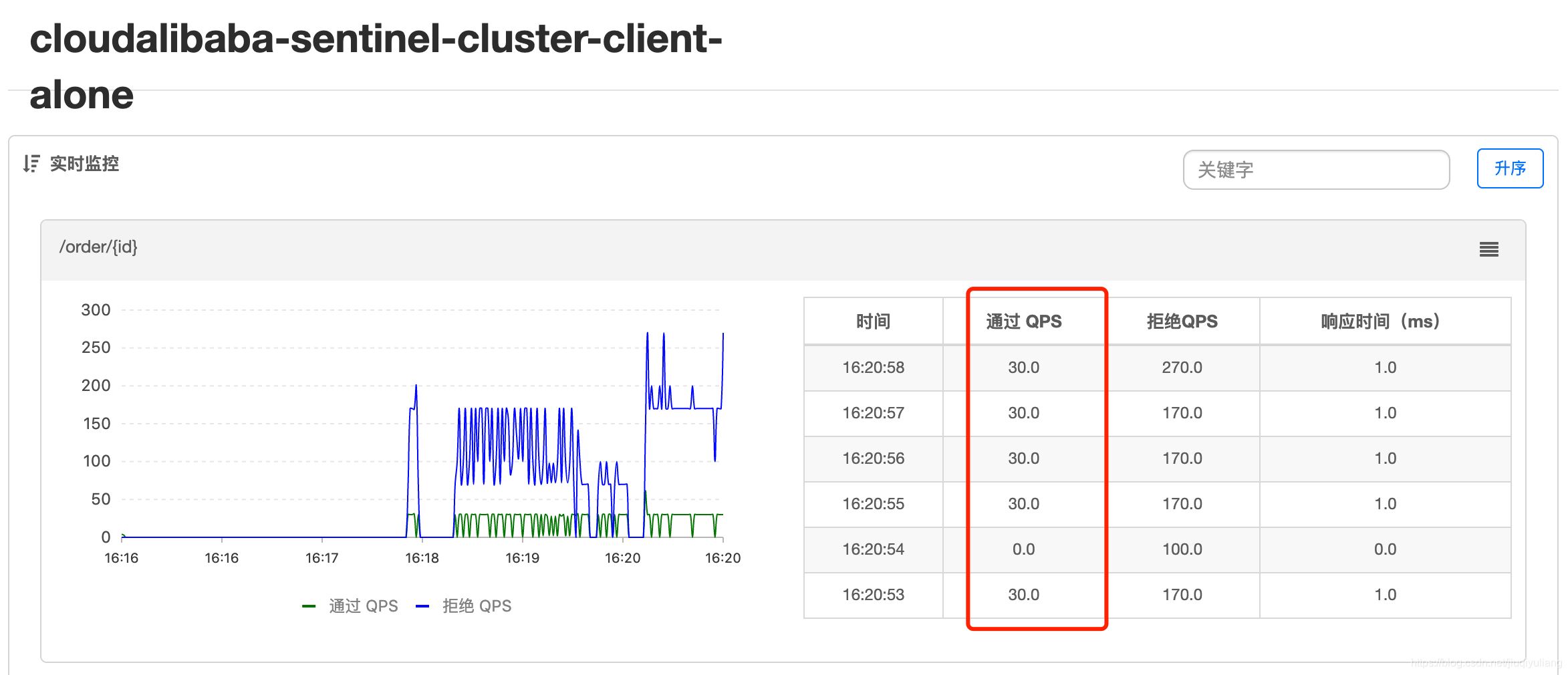
熱點限流已經(jīng)為大家實現(xiàn)了,大家可以自行測試,比較簡單,不再累述。
- ab -n 100 -c 50 http://localhost:9092/hot_order/1/hot
- ab -n 100 -c 50 http://localhost:9094/hot_order/1/hot
- ab -n 100 -c 50 http://localhost:9092/hot_order/1/nothot
- ab -n 100 -c 50 http://localhost:9094/hot_order/1/nothot
其它
若在生產(chǎn)環(huán)境使用集群限流,管控端還需要關(guān)注以下的問題:
- Token Server 自動管理、調(diào)度(分配/選舉 Token Server)
- Token Server 高可用,在某個 server 不可用時自動 failover 到其它機器
總結(jié)
集群流控,有兩種模式,嵌入模式和獨立模式,個人不建議在業(yè)務(wù)系統(tǒng)使用集群流控,集群流控可以在網(wǎng)關(guān)層做,業(yè)務(wù)層的話可以使用單機流控,相對來說簡單好上手。token server目前存在單點問題,需要個人實現(xiàn)master選舉,并修改 cluster-server-config的IP即可。
代碼示例
本文示例讀者可以通過查看下面?zhèn)}庫中的項目,如下所示:
- <module>cloudalibaba-sentinel-cluster</module>
github:https://github.com/jiuqiyuliang/SpringCloud-Learning
到此這篇關(guān)于Sentinel實現(xiàn)動態(tài)配置的集群流控的文章就介紹到這了,更多相關(guān)Sentinel集群流控內(nèi)容請搜索服務(wù)器之家以前的文章或繼續(xù)瀏覽下面的相關(guān)文章希望大家以后多多支持服務(wù)器之家!
原文鏈接:https://blog.csdn.net/jiuqiyuliang/article/details/115524800













